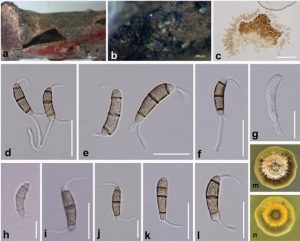Seimatosporium quercinum Goonas., R.K. Schumach. & K.D. Hyde, Goonasekara, Maharachchikumbura, Wijayawardene, Phookamsak, Schumacher, Bahkali, Gareth Jones & Hyde, Phytotaxa 255(3): 244 (2016)
Index Fungorum Number: IF 552011, MycoBank Number: MB 552011, Facesoffungorum Number: FoF 01819
Etymology – quercina refers to the host genus
Saprobic on Quercus robur L. Sexual morph: Undetermined. Asexual morph: Conidiomata up to 3500 μm wide, acervular, immersed when immature, becoming erumpent at maturity, globose to subglobose, unilocular, dark brown to black, dehiscing by an irregular split of the host epidermis. Conidiomata wall not observed. Conidiophores arising from the base of the cavity, 7–9.3 μm, hyaline, filiform to cylindrical, branched at the base, smooth. Conidiogenous cells holoblastic, annellidic, cylindrical, hyaline, smooth. Conidia concolourous, falcate, 3-septate, without constrictions at the septa, 6–8.5(–9) × 1–3 μm (x̅=7.7 × 1.7 μm, n=30), consists of a flattened hilum at base, smooth-walled; basal cell obconic with a truncate base, pale brown to hyaline, 1–1.5 μm long (x̅=2.3 μm), with a long, tubular, simple and unbranched, eccentric appendage, 2–5 μm long (x̅=2.9 μm); middle cells cylindrical, pale brown to medium brown, second cell from base 2.1–3.3 μm long (x̅=2.5 μm), third cell from base 1.8–3.1 μm long (x̅=2.2 μm), together 4.5–6.5 μm long (x̅=5.2 μm), transverse septa dark brown and fairly thick; apical cell conical and rounded at apex, hyaline to pale brown, 0.5–1.6 μm long (x̅=1.1 μm), with a long, tubular, unbranched, central appendage, 2–4 μm long (x̅=3.5 μm).
Culture characteristics – Colonies on MEA show moderate growth, reaching 2 cm diam. after 7 days at 16–18 °C, colonies composed of dense mycelium, circular, smooth, margins undulate, pale grey and umbonate at the very centre, becoming pale to orangish-brown and effuse in the center region, darker brown to pale brown towards the margin on the upper side Brown with a darker brown margin at the center, becoming orangish yellow and pale yellow towards the margin of the colony on the lower side.
Type – GERMANY. On hornbeam wood (Carpinus sp.), elev. = 40 m, on Quercus robur (Fagaceae) twig, attached on a freshly fallen branch, 23 February 2014, René K. Schumacher. 23.02.2014-028 (MFLU 15–0760 holotype, HKAS 91483 isotype), ex-type living culture, MFLUCC 14–1198 = KUMCC 16–0005.
Notes – Three species of Seimatosporium have been reported on Quercus spp. (Farr & Rossman 2016), but are morphologically distinct from S. quercina, which has 3-septate conidia measuring 6–8.5(–9) × 1–3 μm, with a single appendage at each end. Seimatosporium glandigenum (Bubák & Gonz. Frag.) B. Sutton reported on Q. ballota (from Spain) and S. lichenicola (Corda) Shoemaker & E. Müll. reported on Q. ilex (from Italy) have 3-septate, non-appendaged, larger conidia measuring 15–18 × 5–6.5 μm and 13–15 × 5.5–6.5 μm, respectively (Sutton 1980, Greuter et al. 1991, Nag Raj 1993). Seimatosporium caninum (Brunaud) B. Sutton reported on Q. incana in France has 2-septate conidia measuring 9.5–12 × 4.5–5.5 μm (Sutton 1980) and lacks appendages. Our species is further compared to morphologically similar taxa reported in Sutton (1980) and Nag Raj (1993).

Fig. 1. Seimatosporium quercina (holotype). a. Symptoms on twig of Quercus robur. b. Close up of acervuli. c. Conidia with conidiophores attached to the conidioma. d. Conidia attached to conidiophores. e–l. Conidia at different stages of maturity. m, n. Colony on MEA (m-above, n-below). Scale bars: c = 50 μm; d–l = 10 μm.
